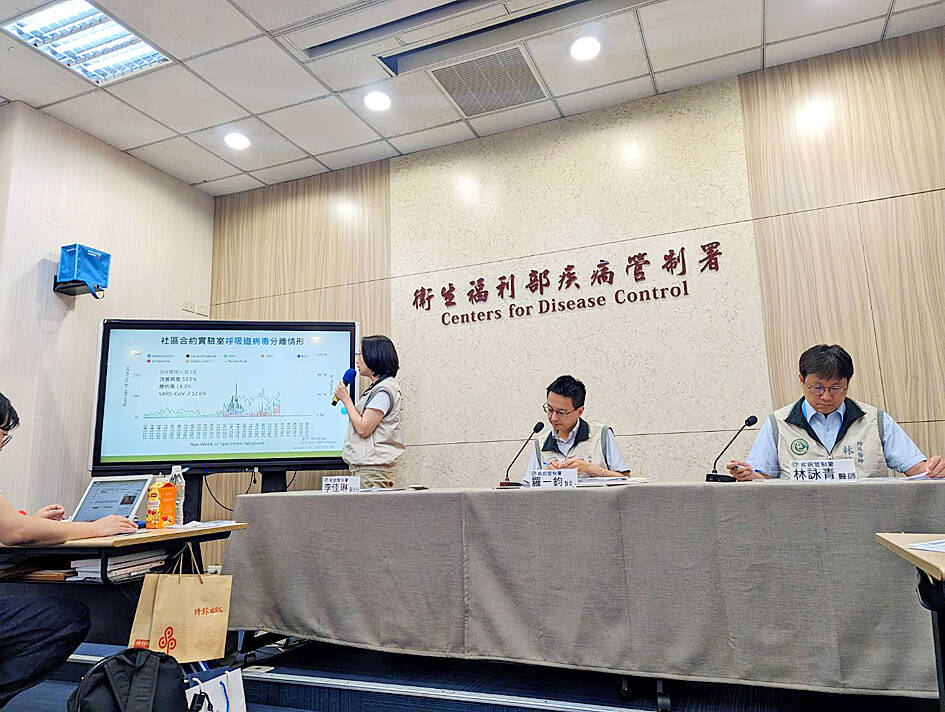Thirty-two cases of serious flu complications and seven flu-related deaths were confirmed last week, while the daily number of new hospitalized COVID-19 cases continued to increase and is expected to remain at a peak next month, the Centers for Disease Control (CDC) said yesterday.
CDC Epidemic Intelligence Center Deputy Director Lee Chia-lin (李佳琳) said that the respiratory viruses identified from last week showed flu viruses accounted for 53.5 percent of the total, and that both the influenza A(H1N1) virus and the influenza A(H3N2) virus were the dominant circulating viruses.
There were 75,897 hospital visits for flu-like illnesses last week, up 4.4 percent from the previous week, she said, adding that an analysis of the trend shows that it would continue increasing.

Photo: Wu Liang-yi, Taipei Times
Among the seven flu-related deaths reported, six had contracted the influenza A(H1N1) virus and one the influenza A(H3N2) virus, she said.
Four of them were not vaccinated, she added.
CDC Deputy Director-General Philip Lo (羅一鈞) said the serious cases and deaths mark the highest weekly numbers this flu season, which started in October last year.
Case numbers might decline as the weather gets warmer, but it is difficult to predict when it would start to drop, he said, adding that after the Dragon Boat Festival on June 22 is a possible period.
CDC physician Lin Yung-ching (林詠青) said the youngest person who died from flu last week was a seven-year-old girl in southern Taiwan, who did not have underlying health conditions and received a flu vaccine this flu season.
The girl developed encephalitis and myocarditis after contracting the flu, and died two days after the onset of symptoms, Lin said.
The CDC also reported a daily average of 208 new cases of moderate-to-severe COVID-19 for last week, an increase of 3 percent from the previous week.
There were also 20 COVID-19-related deaths on average per day last week, higher than the previous week, which Lee said indicates that new COVID-19 cases are still rising.
Genomic sequencing from the past four weeks showed that the Omicron XBB variant was the dominant strain, accounting for 59 percent of the cases, followed by the Omicron BA.2.75 variant at 39 percent, the CDC said.
Similar to the flu, COVID-19 infections are expected to remain at a peak next month, Lo said, reminding people to follow hygiene protocols to prevent infections.
People should cover their nose and mouth when sneezing, wash their hands frequently with soap and water, wear masks in crowded places and seek medical attention if they develop respiratory symptoms, he said.
Wearing a mask is mandatory at healthcare and elderly welfare facilities, and people should seek emergency treatment if they develop symptoms of serious complications, such as difficulty breathing, chest pain and low blood pressure, if they contract the disease, he said.
As for enterovirus infection, Lee said that it is at an epidemic level, with 12,924 hospital visits reported last week, 4 percent higher than the previous week.
However, the pace of increase has slowed in the past two weeks, Lee said, adding that the coxsackie A virus accounted for the majority of the cases, Lee said.
There were also 17 new local mpox cases last week — men aged 20 to 50, with 15 residing in the north and two in central Taiwan.
The CDC urged eligible people to get vaccinated at one of the 93 contracted healthcare facilities across the nation as soon as possible.
A total of 128 mpox cases — 116 local and 12 imported cases — have been confirmed since June 23 last year. Sixty of them have recovered, 15 people are still hospitalized and 53 are under self-health management at home, the CDC said.

Taiwanese actress Barbie Hsu (徐熙媛) has died of pneumonia at the age of 48 while on a trip to Japan, where she contracted influenza during the Lunar New Year holiday, her sister confirmed today through an agent. "Our whole family came to Japan for a trip, and my dearest and most kindhearted sister Barbie Hsu died of influenza-induced pneumonia and unfortunately left us," Hsu's sister and talk show hostess Dee Hsu (徐熙娣) said. "I was grateful to be her sister in this life and that we got to care for and spend time with each other. I will always be grateful to

REMINDER: Of the 6.78 million doses of flu vaccine Taiwan purchased for this flu season, about 200,000 are still available, an official said, following Big S’ death As news broke of the death of Taiwanese actress and singer Barbie Hsu (徐熙媛), also known as Big S (大S), from severe flu complications, the Centers for Disease Control (CDC) and doctors yesterday urged people at high risk to get vaccinated and be alert to signs of severe illness. Hsu’s family yesterday confirmed that the actress died on a family holiday in Japan due to pneumonia during the Lunar New Year holiday. CDC Deputy Director-General Tseng Shu-hui (曾淑慧) told an impromptu news conference that hospital visits for flu-like illnesses from Jan. 19 to Jan. 25 reached 162,352 — the highest

COMBINING FORCES: The 66th Marine Brigade would support the 202nd Military Police Command in its defense of Taipei against ‘decapitation strikes,’ a source said The Marine Corps has deployed more than 100 soldiers and officers of the 66th Marine Brigade to Taipei International Airport (Songshan airport) as part of an effort to bolster defenses around the capital, a source with knowledge of the matter said yesterday. Two weeks ago, a military source said that the Ministry of National Defense ordered the Marine Corps to increase soldier deployments in the Taipei area. The 66th Marine Brigade has been tasked with protecting key areas in Taipei, with the 202nd Military Police Command also continuing to defend the capital. That came after a 2017 decision by the ministry to station

PETITIONS: A Democratic Progressive Party official quoted President William Lai as saying that civil society groups are organizing the recall drives at the grassroots level Some civil society groups yesterday announced that they have collected enough signatures to pass the first-stage threshold to initiate a recall vote against Chinese Nationalist Party (KMT) legislators in 18 constituencies nationwide, saying that they would submit the signatures to the Central Election Commission (CEC) today. They also said that they expected to pass the threshold in eight more constituencies in the coming days, meaning the number of KMT legislators facing a recall vote could reach 26. The groups set up stations to collect signatures at local marketplaces and busy commercial districts. The legislators their petition drives target include Fu